
NATIVE PLANT SUGGESTIONS![]()
![]()
Motivation
![]() Why Natives
Why Natives
![]() Garden Goals
Garden Goals
Site Preparation
![]() Site Analysis
Site Analysis
![]() Site Plan
Site Plan
![]() Hardscapes
Hardscapes
Plant Selection
![]() Which Native
Which Native
![]() Planting Hints
Planting Hints
![]() Suggested Plants
Suggested Plants

Coast Silk Tassel
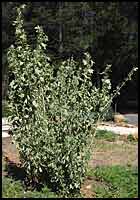
Chaparral Mallow
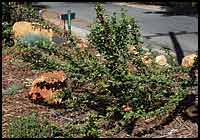
Wild Gooseberry
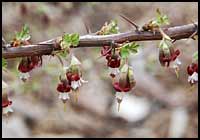
Gooseberry blossoms
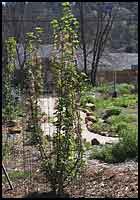
Pink Currant
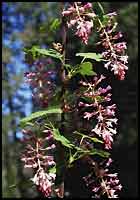
Pink Currant blossoms
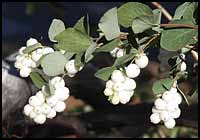
Snowberris are low bushes that often grow near oaks and pines.
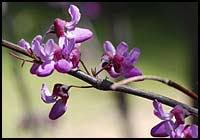
Redbud, shown here in bloom, is a signature shrub or small tree of the foothills.
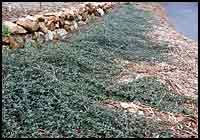
'Centennial' ceanothus groundcover started from 2-inch pots less than two years before.
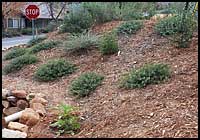
'Emerald Carpet' manzanita started from one-gallon containers one-and-a-half years before.

The poppies, tidy tips and bird's eye gilia seeded themselves in the "dry meadow" for the next year.

Monkeyflowers are small shrubs that may only live a few years but have showy flowers and are easy to propagate from cuttings.
Suggested Plants
An effective way of selecting native plants is to consider their possible functions within the landscape.
-
Try to appeal to all of the senses—sight, sound, smell, touch and taste (maybe not taste).
-
Repetition of plants, balance in shape and color, and contrast in textures, size and colors will add to the overall design of your garden.
-
Plan for a succession of colorful blooms, foliage and berries or seedpods through early spring, late spring, summer, fall and winter.
-
Focal points and destinations can be achieved through massed planting, drifts of color or with a single specimen plant.
-
Plants combined with hardscapes provide beauty, screen undesirable views, guide visitors in the garden or create points of interest.
-
Think about what the plants may look like in five, ten or more years. Allow space for the plants to grow.
-
Try to anticipate any problems that may arise from poor plant selection. For example, if you have a leach line area where you want to avoid deep roots, you may want to plan a “dry meadow” of wildflowers. If you have a scenic view, avoid planting something that will grow tall and hide it. Consider your neighbors’ yards and avoid conflicting plants. Your neighbor's plants may complement your own, provide shade on your property and add visual appeal.
-
Keep records of what you have planted. Plant tags will get lost somehow and you are likely to forget the plant names in the future.
- Locate plants according to their desirable growing conditions (sun, shade, moisture, soil type and appropriateness to your gardening zone).
Go back to your site plan and draw symbols to indicate trees, shrubs, smaller plants and special features. You can then start considering specific plants to place in those locations. The choices may seem overwhelming, but there are many books and places to visit, either in person or on the Internet, that will help you learn about specific plants.
Backbone Plants
It makes sense to start with the larger shrubs that will provide a “backbone” for your garden. It is one thing to read that a plant may reach 12 feet in height and width, and quite another to actually see a plant this big. You might make a trip to the UCDavis Arboretum to view fully mature native plants. It is practically guaranteed that you will then use a measuring tape to carefully provide room for your plants to grow.
When you first put the backbone plants in place, you may think the small plants look skimpy. Be assured that they will grow to fill the space that you allow. If, for some reason, they don’t get as big as you expected, you can always add something later. In fact, you can temporarily fill in between your backbone plants with annuals or small understory plants.
Large shrubs that do well in the foothills include toyon (Heteromeles arbutifolia), redbud (Cercis occidentalis), currant (both Ribes aureum and Ribes sanguineum), coast silk tassel (Garrya elliptica), coffeeberry (Rhamnus californica), spice bush (Calycanthus occidentalis), western mock orange (Philadelphus lewisii), bush anemone (Carpentaria occidentalis), large ceanothus species (very tasty to deer) and varieties of manzanita.
Additional large shrubs or small trees include mountain mahogany (Cercocarpus betuloides), western elderberry (Sambucus mexicana) and California bay (Umbellularia californica). You may already have some large oaks, pine, buck brush, deer brush and manzanita on your property.
Specimen Plants
Some of the shrubs mentioned above are excellent specimen plants with showy flowers, interesting foliage or colored berries. Place them so they can be appreciated from pathways and viewed from various locations in the garden.
Additional plants to consider include bush mallow (Malacothamnus species), fuchsia-flowered gooseberry (Ribes speciosum) and snowdrop bush (Styrax redivivus).
Small Shrubs and Perennials
There are far too many native plants to list them all here. Many suggestions will be found in the books and links listed under Resources. Some successful ones include the bush silver lupine (Lupinus albifrons), sticky monkeyflower (Mimulus aurantiacus), foothill penstemon (Penstemon heterophyllus), holly-leaf redberry (Rhamnus ilicifolia) and sages (Salvia species).
Groundcovers
Ground covers are used to cover an area visually and to suppress weeds. There are small-leaved ceanothus, sage and manzanita species that the deer will ignore. Coyote mint (Monardella villosa) grows vigorously.
Wildflowers
Wildflowers are a thrill to find in the woods and we are often tempted to duplicate them in our gardens. Please do not try to transplant them to your yard. They need the conditions in the wild and are bound to fail when transplanted. It is better to leave them there for others to enjoy and you will know a special place that you can visit each year for your own enjoyment.
You can purchase plants at plant sales and nurseries, often starting with an inexpensive 2-inch pot and ending up with a large, beautiful plant. You can also try your hand at growing from seed or propagating cuttings from your friends’ gardens.
If you buy a mix of wildflower seeds, look at the varieties included to see if they are appropriate to the foothill area. A Central California mix thrives well, although it includes some flowers not found in the foothills. Sowing the seed in the fall is considered to be best, but some gardeners find success with seed sown in late January through February. The flowers will be delayed, however.
Some wildflowers will readily appear in the garden year-after-year. This is especially true of the California poppy.
Bulbs and Iris
Bulbs require careful placement and usually no summer water, but they can be spectacular in the garden. They do not bloom until they reach maturity, and they may not bloom at all in some years. Douglas irises, the native Bowl-tubed Iris (Iris macrosiphon) and blue-eyed grass (Sysrinchium bellum) do particularly well.
Deer Resistant Plants
Deer resistance is hard to gauge. In some seasons the deer will be hungry and will try anything, even the plants that are labeled deer resistant. Sometimes they just take a bite or two and go on to another plant. Many shrubs are pruned by deer eating the fresh leaves at the tips of branches, but the shrubs gradually grow larger anyway. If you suspect that something will be tasty to deer, enclose the plant with a wire cage while it is young. Small plants may be covered with gopher baskets turned upside down. Taller plants may be surrounded with circles of wire fencing or concrete reinforcement wire. You can also try commercial deer repellants in spray or granular form.